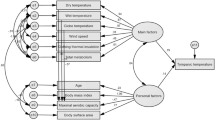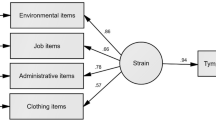Abstract
Until now, only a few comprehensive studies have validated analytical heat stress indices in different conditions. The present study aims to investigate the validity of these indicators in predicting the physiological parameters of workers. This cross-sectional study was conducted with 194 male employees working in warm environments. First, demographic information was collected. After participants rested for 30 min, their heart rate and tympanic temperature were measured. The subjects then performed their routine tasks. At the end of 90 min, their heart rate and tympanic temperature were again measured. Additionally, their metabolism rate and clothing thermal insulation were estimated. Environmental parameters were also measured at 30-, 60-, and 90-min time points. Additional information required to compute the indices was recorded. Then, the values of each of the indices were computed. Finally, the validity of the indices was assessed under different conditions. The results indicated that the highest regression coefficients with tympanic temperature were assigned to modified physiologically equivalent temperature (mPET) (0.7515), predicted heat strain (PHS) (0.7201), and predicted mean vote (PMV) (0.7082), index, respectively. Also, the greatest regression coefficients with heart rate belonged to mPET (0.7773), PMV (0.7624), and PHS (0.6479) index, respectively. Based on the results, the highest diagnostic accuracies of receiver operating characteristic (ROC) curves for tympanic temperature were related to indices of mPET, PHS, and PMV with the area under the ROC curve (AUC) of 0.945, 0.931, and 0.930, respectively. Of the studied indices, it was observed that mPET, PHS, PMV, and PPD showed more validity compared to others.



Similar content being viewed by others

Data availability
The datasets used and/or analyzed during the current study are available from the corresponding author upon reasonable request.
References
AC08013703, A (2008) Ergonomics of the thermal environment-estimation of thermal insulation and water vapour resistance of a clothing ensemble. ISO
Alemayehu D, Zou KH (2012) Applications of ROC analysis in medical research: recent developments and future directions. Acad Radiol 19(12):1457–1464
Alfano FR, Palella BI, Riccio G (2011) The role of measurement accuracy on the thermal environment assessment by means of PMV index. Build Environ 46(7):1361–1369
Alfano FR, Palella BI, Riccio G (2016) Notes on the calculation of the PMV index by means of apps. Energy Procedia 101:249–256
Arbuthnott K, Hajat S, Heaviside C, Vardoulakis S (2020) Years of life lost and mortality due to heat and cold in the three largest English cities. Environ Int 144:105966
Ballinas M, Morales-Santiago SI, Barradas VL, Lira A, Oliva-Salinas G (2022) Is PET an adequate index to determine human thermal comfort in Mexico City? Sustainability 14(19):12539
Biabani A, Falahati M, Alimohammadi I, Zokaei M, Jalilian H, Dehghani A, Majareh MN (2021) Validation of heat pressure assessment (HPA) method and WBGT index in Iranian South Oil Company. J Health Saf Work 11(1):106–116
Bonell A, Hirst J, Vicedo-Cabrera AM, Haines A, Prentice AM, Maxwell NS (2020) A protocol for an observational cohort study of heat strain and its effect on fetal wellbeing in pregnant farmers in The Gambia. Wellcome Open Res 5:32–52
Brake DJ, Bates GP (2002) Limiting metabolic rate (thermal work limit) as an index of thermal stress. Appl Occup Environ Hyg 17(3):176–186
Broday EE, Ruivo CR, da Silva MG (2021) The use of Monte Carlo method to assess the uncertainty of thermal comfort indices PMV and PPD: benefits of using a measuring set with an operative temperature probe. J Build Eng 35:101961
Chen R, Yin P, Wang L, Liu C, Niu Y, Wang W, Jiang Y, Liu Y, Liu J, Qi J (2018) Association between ambient temperature and mortality risk and burden: time series study in 272 main Chinese cities. BMJ 363:k4306
Chen Y-C, Chen W-N, Chou CC-K, Matzarakis A (2020) Concepts and new implements for modified physiologically equivalent temperature. Atmosphere 11(7):694
Chen Y-C, Matzarakis A (2018) Modified physiologically equivalent temperature—basics and applications for western European climate. Theor Appl Climatol 132:1275–1289
Cheung T, Schiavon S, Parkinson T, Li P, Brager G (2019) Analysis of the accuracy on PMV–PPD model using the ASHRAE Global Thermal Comfort Database II. Build Environ 153:205–217
De Freitas C, Ryken M (1989) Climate and physiological heat strain during exercise. Int J Biometeorol 33:157–164
de Freitas CR, Grigorieva EA (2017) A comparison and appraisal of a comprehensive range of human thermal climate indices. Int J Biometeorol 61(3):487–512
Dyvia HA, Arif C (2021) Analysis of thermal comfort with predicted mean vote (PMV) index using artificial neural network. IOP Conf Ser Earth Environ Sci 622(1):012019
Febbraio MA (2001) Alterations in energy metabolism during exercise and heat stress. Sports Med 31:47–59
Fröhlich D, Gangwisch M, Matzarakis A (2019) Effect of radiation and wind on thermal comfort in urban environments-application of the RayMan and SkyHelios model. Urban Clim 27:1–7
Fröhlich D, Matzarakis A (2018) Spatial estimation of thermal indices in urban areas—basics of the SkyHelios model. Atmosphere 9(6):209
Gauer R, Meyers BK (2019) Heat-related illnesses. Am Fam Physician 99(8):482–489
Hamerezaee M, Golbabaei F, Nasiri P, Azam K, Dehghan SF, Fathi A, Darabi F (2018) Determination of optimum index for heat stress assessment on the basis of physiological parameters, in steel industries. J Health Saf Work 8(2):163–174
Havenith G, Fiala D (2011) Thermal indices and thermophysiological modeling for heat stress. Compr Physiol 6(1):255–302
ISO, B (2004) 8996: 2004 Ergonomics of the thermal environment—determination of metabolic rate. BSI, London
Iso, B (2017) 7243: ergonomics of the thermal environment—assessment of heat stress using the wbgt (wet bulb globe temperature) index. Int Org Standard, Geneva Switzerland
Jendritzky G, de Dear R, Havenith G (2012) UTCI—why another thermal index? Int J Biometeorol 56:421–428
Ji W, Zhu Y, Cao B (2020) Development of the predicted thermal sensation (PTS) model using the ASHRAE global thermal comfort database. Energy Build 211:109780
Ji W, Zhu Y, Du H, Cao B, Lian Z, Geng Y, Liu S, Xiong J, Yang C (2022) Interpretation of standard effective temperature (SET) and explorations on its modification and development. Build Environ 210:108714
Khoshakhlagh AH, Ghasemi M (2017) Occupational noise exposure and hearing impairment among spinningworkers in Iran. Iran Red Crescent Med J 19(5):e42712
Khoshakhlagh AH, Ghasemi M, Pourtaghi G (2017) Association between fatigue and occupational physical trauma among male Iranian workers in the copper extraction industry. Trauma Mon 22(1):e29621
Kim J-H, Min Y-K, Kim B (2013) Is the PMV index an indicator of human thermal comfort sensation. Int J Smart Home 7(1):27–34
Kim Y-M, Kim S, Cheong H-K, Kim E-H (2011) Comparison of temperature indexes for the impact assessment of heat stress on heat-related mortality. Environ Health Toxicol 26:e2011009
Lazaro P, Momayez M (2020) Development of a modified predicted heat strain model for hot work environments. Int J Min Sci Technol 30(4):477–481
Lee HM, Cho CK, Yun MH, Lee MW (1998) Development of a temperature control procedure for a room air-conditioner using the concept of just noticeable difference (JND) in thermal sensation. Int J Ind Ergon 22(3):207–216
Leyk D, Hoitz J, Becker C, Glitz KJ, Nestler K, Piekarski C (2019) Health risks and interventions in exertional heat stress. Dtsch Arztebl Int 116(31-32):537
Li Y, Rezgui Y, Guerriero A, Zhang X, Han M, Kubicki S, Yan D (2020) Development of an adaptation table to enhance the accuracy of the predicted mean vote model. Build Environ 168:106504
Lin T-P, Yang S-R, Chen Y-C, Matzarakis A (2019) The potential of a modified physiologically equivalent temperature (mPET) based on local thermal comfort perception in hot and humid regions. Theor Appl Climatol 135:873–876
Malchaire J (2006) Occupational heat stress assessment by the predicted heat strain model. Ind Health 44(3):380–387
Malchaire J, Piette A, Kampmann B, Mehnert P, Gebhardt H, Havenith G, Den Hartog E, Holmer I, Parsons K, Alfano G (2001) Development and validation of the predicted heat strain model. Ann Occup Hyg 45(2):123–135
Mazon J (2014) The influence of thermal discomfort on the attention index of teenagers: an experimental evaluation. Int J Biometeorol 58(5):717–724
Methner M, Eisenberg J (2018) Evaluation of heat stress and heat strain among employees working outdoors in an extremely hot environment. J Occup Environ Hyg 15(6):474–480
Monazzam M, Golbabaei F, Hematjo R, Hosseini M, Nassiri P, Dehghan SF (2014) Evaluation of DI, WBGT, and SWreq/PHS heat stress indices for estimating the heat load on the employees of a petrochemical industry. Int J Occup Hyg 6(1):6–10
Nassiri P, Monazzam MR, Golbabaei F, Dehghan SF, Rafieepour A, Mortezapour AR, Asghari M (2017) Application of Universal Thermal Climate Index (UTCI) for assessment of occupational heat stress in open-pit mines. Ind Health 55(5):437–443
Neira M, Erguler K, Ahmady-Birgani H, Al-Hmoud ND, Fears R, Gogos C, Hobbhahn N, Koliou M, Kostrikis LG, Lelieveld J, Majeed A, Paz S, Rudich Y, Saad-Hussein A, Shaheen M, Tobias A, Christophides G (2023) Climate change and human health in the Eastern Mediterranean and Middle East: literature review, research priorities and policy suggestions. Environ Res 216:114537
Omidvar A, Kim J (2020) Modification of sweat evaporative heat loss in the PMV/PPD model to improve thermal comfort prediction in warm climates. Build Environ 176:106868
Scovronick N, Sera F, Acquaotta F, Garzena D, Fratianni S, Wright CY, Gasparrini A (2018) The association between ambient temperature and mortality in South Africa: a time-series analysis. Environ Res 161:229–235
Shaeri J, Mahdavinejad M (2022) Prediction indoor thermal comfort in traditional houses of Shiraz with PMV/PPD model. Int J Ambient Energy 43(1):8316–8334
Standard, I (2004) “9886,” ergonomics-evaluation of thermal strain by physiological measurements second edition. International Standard Organization, pp 1–21
Standardization, IOF (2005) Ergonomics of the thermal environment: analytical determination and interpretation of thermal comfort using calculation of the PMV and PPD indices and local thermal comfort criteria. International Organization for Standardization
Tansey EA, Johnson CD (2015) Recent advances in thermoregulation. Adv Physiol Educ 39:139–148
Vatani J, Golbabaei F, Dehghan SF, Yousefi A (2016) Applicability of Universal Thermal Climate Index (UTCI) in occupational heat stress assessment: a case study in brick industries. Ind Health 54(1):14–19
Yazdanirad S, Golbabaei F, Monazzam MR, Dehghan H, Foroushani AR (2020a) Development of a personal heat strain risk assessment (PHSRA) index in workplaces and its validation. BMC Public Health 20:1–10
Yazdanirad S, Golbabaei F, Monazzam MR, Dehghan H, Foroushani AR (2020b) Identification, classification, and prioritization of effective factors in producing thermal strain in men at workplaces using fuzzy AHP technique. Indian J Occup Environ Med 24(2):106
Zhang S, Lin Z (2020) Predicted mean vote with skin temperature from standard effective temperature model. Build Environ 183:107133
Acknowledgements
Researchers need to thank all workers who have participated in this study.
Funding
This research was supported by the Shahrekord University of Medical Sciences.
Author information
Authors and Affiliations
Corresponding author
Ethics declarations
Competing interests
The authors declare no competing interests.
Rights and permissions
Springer Nature or its licensor (e.g. a society or other partner) holds exclusive rights to this article under a publishing agreement with the author(s) or other rightsholder(s); author self-archiving of the accepted manuscript version of this article is solely governed by the terms of such publishing agreement and applicable law.
About this article
Cite this article
Abbasi, M., Golbabaei, F., Yazdanirad, S. et al. Validity of ten analytical heat stress indices in predicting the physiological parameters of people under various occupational and meteorological conditions. Int J Biometeorol 68, 163–177 (2024). https://doi.org/10.1007/s00484-023-02580-7
Received:
Revised:
Accepted:
Published:
Issue Date:
DOI: https://doi.org/10.1007/s00484-023-02580-7



